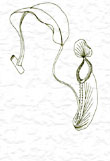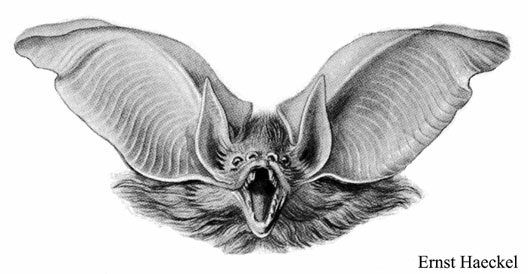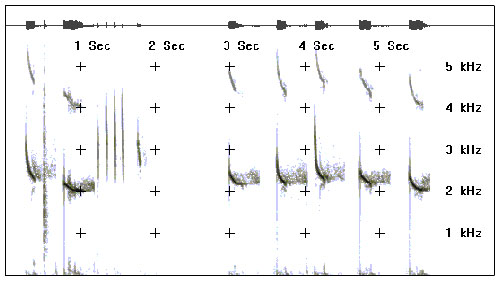

 |
 |
Vertebrates
Understanding bat language: The echolocation calls of Hong Kong bats
by Jacqueline Weir
 |
Bats in Hong Kong
So far there are known to be twenty-two bat species in Hong Kong. Of these, four have been first recorded since 1974. The bamboo bat (Tylonycteris pachypus), was only discovered here in 1996, after a male bat entered a building at Kadoorie Agricultural Research Centre (Ades, 1996). It is possible that, with continued research, yet more species will be found to live here.
In Europe, the very common ‘Pipistrelle’ bat, formerly known as Pipistrellus pipistrellus, was recently found to comprise two distinct species. The initial distinction was made due to slight frequency differences in ultrasound calls of the bats. Differences were eventually confirmed by DNA sequencing (Barratt et al, 1997).
Other new species have also been identified by characteristics of their ultrasound calls, despite being morphologically similar (Jones, 2000). By using technology to listen in on the acoustic world of bats, it may be that a vast amount of ‘hidden’ diversity among these creatures is discovered. This applies particularly to Hong Kong, where the species list for bats continues to grow.
In addition to this potential, knowledge of bat ultrasound calls can be extremely useful in field surveys and population studies of known species. Listening to characteristic calls of different bat species can allow identification in a field situation, without necessarily having to see the animal that is calling!
While in Hong Kong this spring, I have been attempting to record and catalogue calls from as many bat species as I can. In this article I hope to outline the theory behind ‘bat detection’, and what I have been trying to achieve.
I hope to provide a basis for some bat call identification in Hong Kong, and present the results for use by others. Due to the restricted time frame of the project, there is little hope of recording all types of call from all insectivorous bats here, or of repeating species recordings numerous times, but I hope that the list of species I record will be added to in future. In order to explain my project better, the following section describes some of the theory and technology behind what I have been doing.
Echolocation Calls and Bat Detectors
Echolocation is the method used by insectivorous bats both to navigate and to catch their prey. Calls of very high frequency sound are produced, usually at an ultrasonic level too high for the human ear to hear. These sounds are reflected off surfaces near to the bat, and the time it takes for an echo to reach the bat indicates distance to a particular surface. Because bats are often moving as they call, as is their prey, calls need to be repeated extremely rapidly in order to update the information received from these echoes.
Echolocation calls of bats can be heard by humans, by means of ‘bat detectors’, which convert the very high frequency calls into lower frequency sounds detectable by the human ear. Using this method it is possible to distinguish between bat species by the sounds they produce.
Fruit bats, while using some ultrasound component in their social calls, usually do not use echolocation as a method of navigation, as their senses of sight and smell are sufficient to locate the required food sources. Calls produced by insectivorous bats also reflect the nature of their food source, in particular the size of prey, as well as the habitat in which they fly, and the body size and wing design of the bat species (Briggs and King, 1998). This means that individual insectivorous species have a repertoire of calls that distinguishes them from others. Using bat detectors this world of sound can be entered, and the language of different species can begin to be deciphered.
While this technology is quite widespread in the U.K., very little use has been made of it so far in Hong Kong. Having become interested in its potential while at home in Britain, I decided to employ it in Hong Kong, and began a project on the calls made by bats here. If a catalogue could be built up of calls from different Hong Kong species this would greatly increase ease of identification, especially of bats in flight, without the need to disturb or catch the animals. This would have benefits for ecological consultancy, population estimates and distribution studies.
The most basic type of bat detector is known as a ‘heterodyne’ detector. This converts the bat call into an electronic signal, which is compared against a signal produced within the detector. The internal signal is varied by tuning the detector, and the audible sound produced is the difference between the two signals (Briggs and King, 1998).
More sophisticated methods of detection include ‘time expansion’ and ‘frequency division’. Time expansion detectors briefly record the ultrasonic signals, then play them back both at lower frequency and a slower speed. There may be an option of ‘/10’, or alternative settings. At /10, the frequency is lowered by a factor of 10, and the time over which the signals are played is increased by a factor of 10. This setting is often used when calls are to be analysed by computer. At, for example, /32, a factor of 32 is employed. This produces a sound that is easy for the human ear to pick up (see bat detector user guides). The main drawback of time expansion systems is that recording stops while the previous sound is slowed down, so some incident calls may be missed (Catto and Walsh, 2000).
Frequency division detectors lower the frequency of sounds by measuring incident wavelength, and producing a new sound wave which passes through, for example, every tenth zero point of the wave. Thus wavelength is increased, and frequency reduced. However using this method, some information contained in the original sound wave is lost (Catto and Walsh, 2000).
Once converted by a bat detector, signals can be recorded and analysed. Computer analysis of calls gives a tangible method of species identification, by visually representing calls as graphs. Useful graphical representation of calls can be as ‘sonograms’, which show call frequency against time (Fig. 1), and as ‘power spectra’, which plot frequency against amplitude of the call (Russ, 1999).
The frequency scale should be multiplied by ten and the time scale divided by ten, to obtain true values for the recording.
 |
Figure 1 – Sonogram of a bat call, using a time expansion factor of ten.
In order to distinguish different, previously unrecorded, species, initially a positive identification is necessary in the field. The resultant graphs of calls can then be attributed to that species. Multiple recordings of each species are useful, both to verify the original recordings, and because each species has numerous calls that depend largely on where the bats are flying. Ideally, analysis should be carried out on a large number of recordings for each species, but it is anticipated that this short study (which spans three months) will not gain enough information to make this possible. However despite little repetition of recordings, it is hoped that the project will provide enough information to catalogue the calls of some Hong Kong species, and enable their identification with bat detectors.
Project Aims
The main aim of the project is to obtain clear recordings, using both time expanded and heterodyne functions, of as many Hong Kong bat species as possible, then to analyse and catalogue these as an aid to field identification. For some species the frequencies and shapes of calls can be estimated prior to recording, due to records of similar species, or of the same species in different geographical locations. These can be used for comparison with recordings obtained in Hong Kong.
Recordings are made, as far as possible, from bats flying in similar habitats. This allows more direct comparisons between calls from different species, as calls vary between open and cluttered habitats (Russ, 1999). Ideally, recordings are made for each species from a variety of habitats, and on each occasion the weather conditions, habitat type and flight patterns of bats are recorded.
Another aim of the project is to increase awareness in Hong Kong of the potential of these techniques. Widespread use of these detectors, some of which can be obtained cheaply and are simple to use, would allow a great deal more information on Hong Kong bats to be gathered, with relative ease.
Project Results
Results will be written up, for as many species as I manage to record, to provide a basis for future work in this area. The calls will be displayed as sonograms, to provide visual images of the vocal ‘signatures’ of different species. I also plan to provide information from power spectra, on parameters of typical calls for each species.
The cheapest, most ‘accessible’ type of bat detector is the heterodyne detector. With this in mind, I will provide descriptions of each call as it would be heard on a heterodyne detector. While time expanded recording is more useful for indisputable identification, some calls sound very distinctive using the heterodyne method, and this remains a valuable field tool.
For further information on bat detectors, or to order equipment, try visiting http://www.biology.leeds.ac.uk/staff/dawa/bats/detector.htm. Also, keep an eye out on coming Porcupine! issues, for where to find published results of this project.
On a final note, recently while walking in Tai Po Kau forest I was circled by a bat which flew out of some vegetation, and very quickly disappeared back into it. This unusual experience was intensified by being able to listen to the animal as it flew around me. The potential of the bat detector as a scientific tool is complimented by the sheer pleasure of listening in on a world which is normally hidden from our ears.
Bibliography
Barratt, E. M., Deaville, R., Burland, T. M., Bruford, M. W., Jones, G., Racey, P. A. and Wayne, R. K. (1997). DNA answers the call of pipistrelle bat species. Nature 387: 138–139.
Briggs, B. and King, D., (1998). The Bat Detective - A Field Guide for Bat Detection, pp. 11-16. Stag Electronics. ISBN 0 9532426 0 9.
Catto, C. and Walsh, A. (2000). (Editors). Bat detector systems. The Bat Conservation Trust Bat Monitoring Post. The Newsletter of the BCT’s National Bat Monitoring Programme 5 April 2000: 12-15.
Jones, G. (2000). Uncommon discoveries about one of Europe’s most common bats. Bats - Bat Conservation International 18 (4) Winter 2000: 1-4.
Russ, J. (1999). The Bats of Britain and Ireland - Echolocation Calls, Sound Analysis and Species Identification, pp. 15-17, 81. Alana Books. Alana Ecology Ltd. ISBN 0 9536049 0 X.
P.11-13
|
Porcupine! |
 Copyright © 2000 |